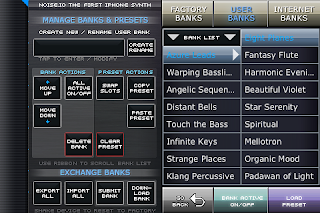
Yesterday I talked about Noise IO Pro and ESFM which is essentially at the core of Noise IO (and indeed the family of apps that is growing up from Amidio).
Today I want to mention how Noise IO makes use of the the unique interface possibilities of the iPhone platform. Noise IO allows you to map to a variety of parameters. These are:
- Up-Down (Y Axis)
- Left-Right (X Axis)
- Multitouch ("Between" Axis - distance between fingers during pinching action)
- Accelerometer Roll (holding the device horizontally, roll it from left to right in a
- waving manner)
- Accelerometer Tilt (tilt the device back and forth)
It might look like a short list, but it should not be underestimated. Mapping parameters to these Axes can give you enormous control over your sound, and you can map almost parameter from globals to LFOs.
What this gives you in an incredibly versatile performance instrument, with an almost overwhelming amount of choice about how you control it and in what way and to what degree.
Mapping to axes allows you to set the start and stop value levels for any parameter that is mapped so you can make it as sensitive or blunt as you like.
All in all this makes mapping a huge part of Noise IO Pro, especially if you are using it for performance. I want to write in a bit more depth about performance so I'll leave that for another day.
Get Noise IO Pro at the App Store
No comments:
Post a Comment